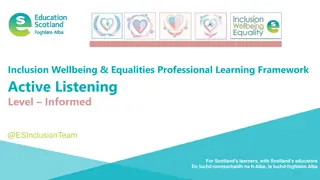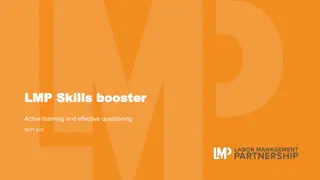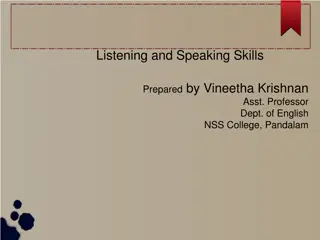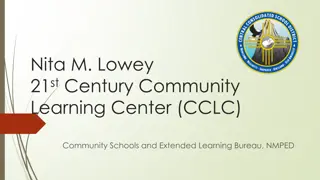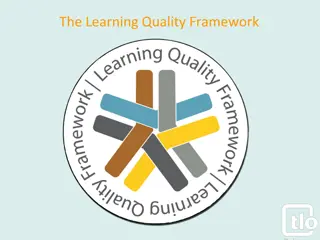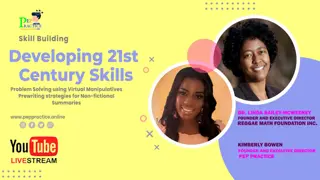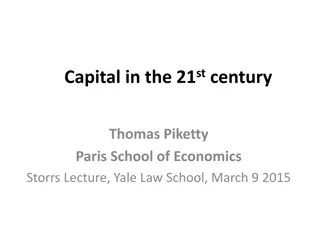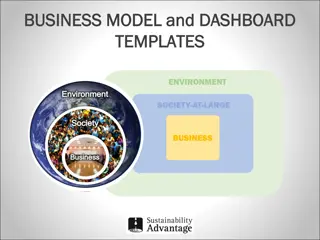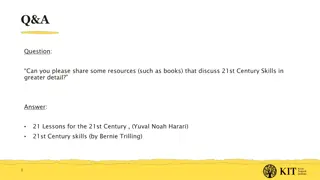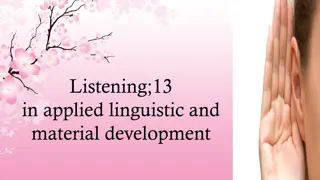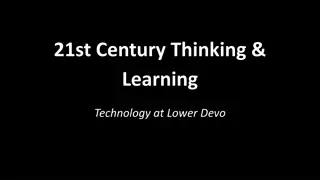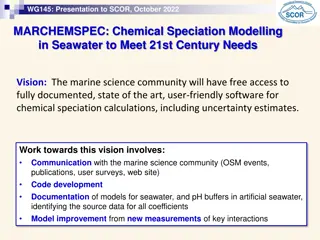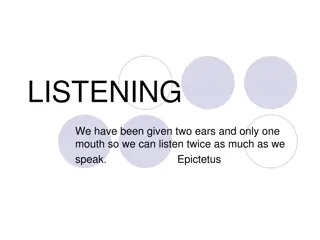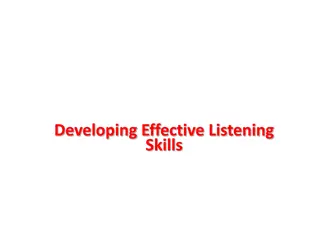
Exploring the Needs of Learning: 21st Century Perspectives
Discover the evolving needs of learning in the 21st century through exploring neuroscience, psychology, sociology, and innovative research designs. Gain insights on how learning involves the brain, cognitive states, human behavior, and social interactions, shaping educational practices for the future.
Download Presentation

Please find below an Image/Link to download the presentation.
The content on the website is provided AS IS for your information and personal use only. It may not be sold, licensed, or shared on other websites without obtaining consent from the author. If you encounter any issues during the download, it is possible that the publisher has removed the file from their server.
You are allowed to download the files provided on this website for personal or commercial use, subject to the condition that they are used lawfully. All files are the property of their respective owners.
The content on the website is provided AS IS for your information and personal use only. It may not be sold, licensed, or shared on other websites without obtaining consent from the author.
E N D
Presentation Transcript
E XP LOR I NG THE NE E DS OF E XP LOR I NG THE NE E DS OF LE AR NI NG E F L LI STE NI NG I N THE LE AR NI NG E F L LI STE NI NG I N THE 2 1ST CE NTU R Y 2 1ST CE NTU R Y by Aisyah Nurjanah Wakhid Nahsruddin Nana Priajana IAIN Syekh Nurjati Cirebon
I ntro duc ti o n I ntro duc ti o n 2 1st Century 2 1st Century Learni ng Learni ng Learning involves physics and beyond physics (Nashruddin & Mustaqimah, 2020, p. 2) The rapid change of technology has influenced human life, including learning (Laar, 2020, p. 1) T Theo ri si ng heo ri si ng fo r i nno vati o ns i nno vati o ns Developing research designs that consider fresh perspectives to discover unexpected connections (Lian & Pertiwi, 2017, p. 3) fo r The Needs o f Learni ng The Needs o f Learni ng The needs of learning are different from previous time (Parsons, Lin, & Cockerham, 2019, p. 7)
Learni ng b ased o n Learni ng b ased o n neuro sc i enc e p ersp ec ti ve neuro sc i enc e p ersp ec ti ve What does learning involve? 1) Involving the brain in understanding, processing, and reasoning the information 2) Involving sensory functions of the brain in the thalamus 3) Involving movement functions of the brain in the basal ganglia 4) Involving memory functions of the brain in the hippocampus 5) Involving emotion functions of the brain in the amygdala Neuroscience sees learning as a change in cognitive state due to acquiring new information by understanding, processing, and reasoning the information that involve sense, movement, memory and emotion (Gluck, Mercado, & Myers, 2016, Koob, Moal, & Thompson, 2010)
Learni ng b ased o n Learni ng b ased o n p p syc ho l o gy syc ho l o gy p ersp ec ti ve p ersp ec ti ve sees how the Psychology relation of human behaviour and learning respectively. There are five theories of learning, namely behaviourism, humanism, cognitivism, constructivism, and connectivism (Ahmad, 2020, Barkeley Graduate Division, 2016) What does learning involve? 1) Involving stimulus to have responses 2) Emphasizing humanity 3) Generating active construction of interpreting new knowledge based personal experience. 4) Engaging social involvement 5) Activating virtual environment
Learni ng b ased o n Learni ng b ased o n so c i o l o gy so c i o l o gy p ersp ec ti ve p ersp ec ti ve --------------------- --------------------- --------------------- --------------------- --------------------- --------------------- What does learning involve? 1) Interacting with other people 2) Avoiding gender inequality 3) Associating small or intimate group 4) Embroiling family learning Sociology sees learning as an act that requires interaction with other, most effectively in a small, intimate group such as family, and should inequality (Ritzer & Ryan, 2011) avoid gender
Learni ng b ased o n Learni ng b ased o n E ngl i sh l anguage teac hi ng E ngl i sh l anguage teac hi ng p ersp ec ti ve p ersp ec ti ve What does learning involve? 1) Requiring practice or training 2) Requiring experience 3) Involving significant skills to work 4) properly as an individual in society ELT sees learning as the mechanism through which actions, information, or skills, change through practice, training or experience as a result of such a mechanism, and the transfer of learning are individuals to acquire significant skills that work properly as an individual in society (Bransford, 2000, Richards & Schmidt, 2010) essential for
Learni ng b ased o n Learni ng b ased o n 2 1st Century 2 1st Century p ersp ec ti ve p ersp ec ti ve What does learning involve? Concerning rapid technological advance Integrating soft skills Implicating learning and innovation skills (critical thinking and problem solving, communication and collaboration, creativity and innovation) Implicating digital literacy skills (information literacy, media literacy, ICT) Implicating life and career skills (flexibility-adaptability, initiative-self-direction, social-cross cultural interaction, productivity-accountability, leadership-responsibility) Learning in the 21st century faces a dynamic situation that is different from the previous times. People in the twenty-first century should possess three skill sets: learning- innovation, digital literacy, and life-career skills (Eaton, 2010, Partnership 21, 2019)
Learni ng b ased o n Learni ng b ased o n l i steni ng ski l l s l i steni ng ski l l s p ersp ec ti ve p ersp ec ti ve --------------------- --------------------- --------------------- --------------------- --------------------- --------------------- about the concept of listening, which could improves pedagogical comprehension and make teaching listening easier (Lin & Han, 2017, Vandergrift & Goh, 2012, Rost, 2011) What does learning involve? 1) Paying attention 2) Involving affective factors 3) Involving prior knowledge 4) Involving environment 5) Giving response 6) Generating working memory 7) Involving micro skills of listening 8) Involving macro skills of listening Listening comprehension involved various active processes in understanding and meaning-making spoken language. Then, better understanding of the listening process could improves L2 ability and encourages teachers to learn more
Co nc l usi o n Co nc l usi o n The process of learning engage both of physical acts such as how practice and training (ELT perspective), interaction (sociology perspective) and behaviour (psychology perspective) pattern that will likely influence learning process and beyond physics such as how the brain and the emotion (neuroscience perspective) will likely gave impact on learning process. Especially in the 21st century where there are significant changes in each aspect of human life including learning. To achieve better learning in EFL listening, the needs based the concepts learning should be integrated in the learning listening.
Thank Thank yo u yo u Slidesgo Sl i desgo , i nc l udi ng reep i k F reep i k. CRE DI TS: Thi s p resenta ti o n tem p l a te wa s c rea ted b y Sl i desgo i c o ns b y F l ati c o n Flaticon F l ati c o n, a nd i nfo gra p hi c s & i m a ges b y F Freepik



